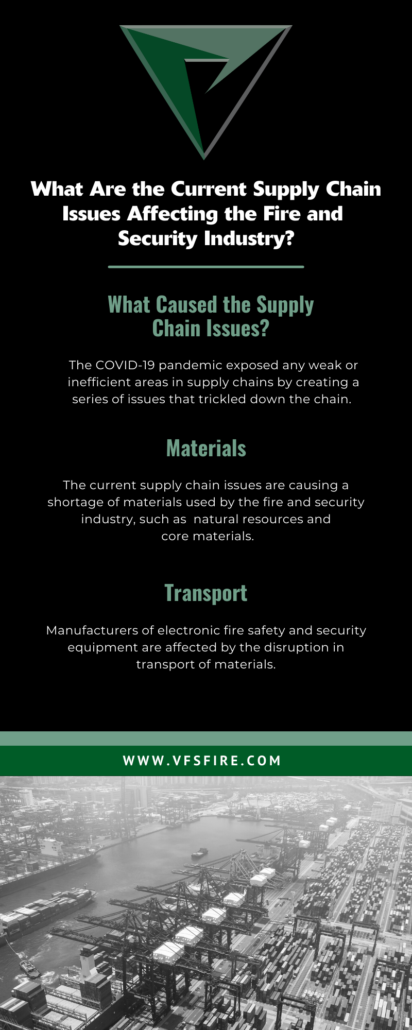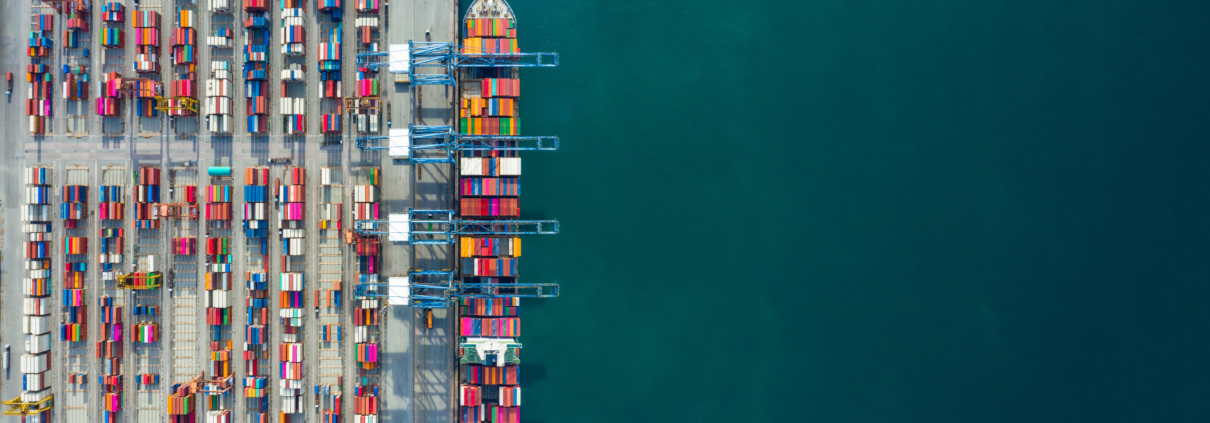Current supply chain issues affect many industries and goods. These impacts range from limited toilet paper on shelves, expensive loaves of bread, and cars taking months at a shop. In addition to these effects, supply chain issues also significantly affect the fire and security industry.
Let’s discuss what supply chains are and how these issues came to be before we hand the reins over to IFSEC Global.
What is a Supply Chain?
According to Fire Apparatus Magazine, a supply chain is defined as “the entire process of making and selling commercial goods including every stage from the supply of materials and the manufacture of the goods to their distribution site.” Supply chains include many elements and moving parts, such as warehouses, production sites, various modes of transportation, fulfillment centers, and inventory storage.
What Caused the Supply Chain Issues?
The COVID-19 pandemic exposed inefficient areas by creating a series of issues that trickled down the chain.
First, any lockdowns, regulations, or ordinances kept workers out of the workplace. Additionally, workers missed work due to COVID-19-related illness, exposure, or other issues. This led to a labor shortage and soon a deficit in materials. The pandemic caused freight costs to spike, shipments to delay and the costs of goods to increase.
Read on for the full article from FSEC Global to learn how these issues affected the fire and security industry.

What are the current supply chain issues affecting the fire and security industry?
Supply chains provide companies with the certainty that raw materials and components will be continually available to ensure the smooth production goods. In this article, Euralarm looks at current issues within the supply chain, and the repercussions those problems are having on the fire and security industry.
The various lockdowns due to the pandemic, paired with high demand due to digitization and economic recovery, meant that the certainty surrounding supply chains was, and is still being, challenged. When manufacturers are looking for alternative material and components they can face re-certification of their products, or newly developed products cannot be released.
As a result, existing products must stay available for longer. The fire safety and security markets are highly dependent on electronics and are largely affected by the supply chain crisis.
Supply chains are formed by complex connections between companies. It starts with the raw materials and ends with finished goods for industry and end user; one chain can include thousands of companies.
Thanks to proven forecasting methods, the activities of the companies in the supply chain are precisely coordinated. This considers demand, supply, seasonal influences or specific characteristics of regions.
What is not considered – and what is not possible – are unknown factors. These can lead to the forecasts no longer being correct. The well-oiled machine of the supply chain then quickly starts to creak and squeak.
COVID-19
One unknown factor the world faced in 2019 was COVID-19, making it clear that society is not prepared for events that are not likely to happen but can have a major impact on society.
Unfortunately, the start of pandemic happened in a country where a large part of the world’s production takes place.
Several industries had problems even before COVID-19. Producers of chips, computer parts and other components needed for the digitalisation of our society were already under great pressure. The production capacity of these goods is limited worldwide and the slightest change in demand can cause supply problems.
This was already the case with smartphones, (game) computers or televisions. Chips had already entered the automotive industry on a large scale, and with the electrification of this industry, the demand for chips soared. We are seeing a similar development in industries and parts of society where the (Industrial) Internet of Things is becoming commonplace.
Risky dependencies
The consequences of the COVID-19 crisis have led many governments to recognise that the high dependence on producers out of one region poses a great a risk to certain sectors. For example, the fact that many European countries have no production capacity for facemasks which were needed during the pandemic.
For electronic chips and components, we face the same challenge; to reduce the risks there is simply a need for more distribution facilities. In the pursuit of lean manufacturing, production has been outsourced to Asia which means that a shutdown of factories in one country can have a global impact. The EU also recognised this even before the pandemic. Accelerated by the corona crisis, the EU is focusing its policy, among other things, on increasing domestic capacity and diversifying the number of suppliers.
Following the rapid spread of the coronavirus in China, European companies were affected. The lockdowns introduced in China led to a virtual standstill in production and restricted the freedom of movement of residents, which also brought logistics providers to a standstill. As quickly as companies were caught off guard by these lockdowns, the recovery in demand was also swift.
For many companies that were caught off guard by global lockdowns, the speed of recovery is almost as insidious and led to another supply chain crisis during the pandemic. Increased consumer spending and thus demand for products, combined with delayed transportation by sea and air, caused major shortages and record backlogs. The tightness on container capacity is expected to continue for some time. This will not help to clear shortages of electronic components, which is expected to continue for some time.
Fire and security
Manufacturers of electronic fire safety and security equipment are affected by the disruption in transport and shortages on natural resources and core materials. COVID-19 has shown that unexpected events can shatter the basic premise that materials will be easily accessible, disrupting supply chain performance. The chain reaction initially caused by the shutdown of factories in countries effected not only the supply chains but also the workflows within and between companies.
Product compliance
Paul van der Zanden, General Director of Euralarm adds: “Another relevant topic that affects our industry is the compliance of the products that the industry delivers. With electronic components not being available due to the supply chain problems, manufacturers need to reconsider replacement of parts that aren’t available. However, with the replacement of certain components, the conformity of the final product may also be at stake.”
This could make it necessary to have the product retested and recertified, resulting in high costs.
When service and maintenance companies were faced with problems in reaching the customers during the pandemic, these organisations learned other flexible ways to stay in contact with their customers.
Many industries and businesses have started modifying their operational methods, now operating online. The fire safety and security industries are doing the same, forming virtual offices and using remote service and diagnostic tools to support their customers.
Customers are moving to hybrid working models which are applied throughout society and could lead to downsizing or repurposing of buildings.
The Green Deal
Securing a sustainable supply of metals and minerals used for components in fire safety and security equipment is also key to meet the energy and climate targets for 2030 and beyond. The European Green Deal aims to make the EU’s economy sustainable. That creates many opportunities for the European society and industry in the current context of both the climate crisis and the COVID-19-outbreak.
However, the transition towards green technologies, like renewable energy, e-mobility and stationary energy storage relies heavily on critical raw materials, such as cobalt, neodymium, tungsten, etc. and on new products and services.
Both globally and in Europe it is expected that the demand for these materials will continue to increase, creating challenges for the Green Deal.
The impact of extracting and processing these resources is high while the supply chains are often not transparent and may lack traceability. Another challenge is the recycling of the materials. For most critical raw materials, the recycling efficiencies are low while the dependency on non-EU countries is high and still increasing.
The green ambitions of the EU could therefore also lead to certain activities being brought back to the West, either to reduce the dependency of non-EU countries, or to avoid CO2 emission as result of transporting goods from other parts of the world to Europe. This could lead to shorter logistics chains and more sustainability in several sectors. In that sense the current crisis in the high-tech supply chains contributes to a greener world and a stronger Europe.



